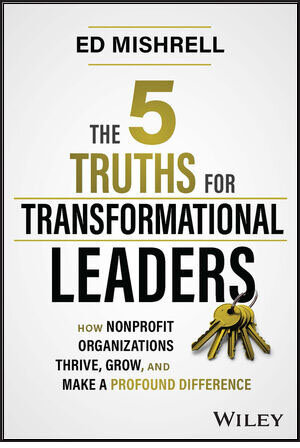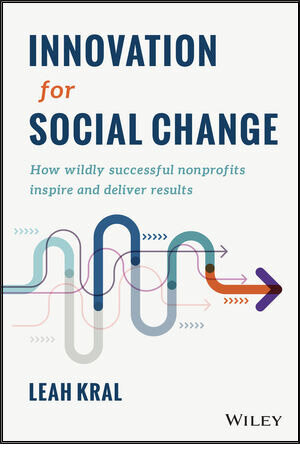The 5 Truths for Transformational Leaders: How Nonprofit Organizations Thrive, Grow, and Make a Profound Difference
In the first paragraph of The 5 Truths for Transformational Leaders: How Nonprofit Organizations Thrive, Grow, and Make a Profound Difference, Ed Mishrell writes: “At their very core the missions and visions of nonprofit organizations are about supporting our aspirations as a nation.” For Mishrell, the success of nonprofits is a matter of national importance. While many factors contribute to such success, he argues that strong, strategic, and committed leadership is essential. Focusing on the role of chief professional officers (CPOs) and boards, the book puts forward an easy-to-understand model for would-be nonprofit leaders to transform organizations.
Transformation is key, and Mishrell focuses specifically on turning struggling organizations into thriving ones. The model draws on his own experience playing different leadership roles at the Boys and Girls Clubs of America (BGCA) and on interviews he conducted with nonprofit staff, leadership, and boards.
As the title suggests, the book distills nonprofit leadership into five truths: 1) Be fanatical about the mission; 2) fix, stabilize, or replace systems, practices, and people who are not working; 3) establish a mission-driven strategy; 4) execution drives results; and 5) continue to grow as a leader.
Mishrell devotes a chapter to each of the five truths, which build one upon the other and correspond to different stages of an organization’s transformation. The first step to turning an organization around, according to Mishrell, is finding a leader who is deeply passionate about the mission. Passion is infectious, he asserts, and leaders who are fanatical about their mission get staff, communities, and donors excited about it as well. Deep and abiding commitment to the mission also provides leaders with the clarity necessary to make tough choices. In fact, when a CPO search committee is faced with two candidates, one who is more qualified on paper and one who is more deeply committed to the mission, Mishrell advises that they choose the latter.
Deep and abiding commitment to the mission also provides leaders with the clarity necessary to make tough choices.
Once a board picks a passionate CPO, the first task for that leader is to stabilize operations, improve efficiency, and ensure that the nonprofit has the right personnel to move forward. An organization cannot sustain growth unless it is operating at peak efficiency, with systems optimized for smooth operations and the right staff. The goal here is for the CPO to eventually stop concerning themselves with day-to-day operations and to instead focus on the long-term goals of the organization.
It is this long-term vision that is the real key to organizational transformation. A mission-driven strategy is where leaders put forward a true vision for the organization and tell the story of how they will do good: whom they will serve, what services they will provide, and how they will measure success. Significantly, Mishrell discourages organizations from making changes to their mission to fit with the goals of grantmakers. Rather, leaders should only seek resources where they can use them to carry out their vision. They should demonstrate why resources are needed to achieve a mission and show how a funder’s contributions will make a difference. In that vein, Mishrell also outlines how organizations can establish a measurement strategy to show that they are meeting their goals and to improve operations.
To execute a mission-driven strategy effectively, nonprofit leaders must be relentless communicators who continually emphasize what the organization is doing and why—so all stakeholders retain and understand their roles in the strategy. In addition, notes Mishrell, leaders must prioritize the most important aspects of a strategy and partner with other organizations to achieve common goals.
Lastly, leaders must learn to change as their organizations transform. As nonprofits grow, CPOs must pivot and get more comfortable delegating tasks. They must move from directing every move the organization makes to teaching others how to make change. Mishrell also recognizes that sometimes organizations outgrow their leaders and that the right leader for one stage in an organization’s development might not be the right leader for another stage.
To execute a mission-driven strategy effectively, nonprofit leaders must be relentless communicators who continually emphasize what the organization is doing and why—so all stakeholders retain and understand their roles in the strategy.
While the five truths feel intuitive, it is the way Mishrell communicates them and builds on them that is truly invaluable. The book is peppered with anecdotes and devices to help would-be CPOs internalize the information. One of these devices is the story of a fictional nonprofit called “The Community Centers of Mission City” that is going through the stages of transformation outlined in the book. The story provides the reader with a concrete and plausible example of how a leader might go about transforming an organization. Furthermore, Mishrell provides the reader with anecdotes from his interviewees as well as from his own experience with BGCA. He also emphasizes the important role that board members play in organizational leadership and development, providing a special section for board members at the end of each chapter. At the end of the book, there is also a “resource center” with worksheets associated with each truth, designed to help CPOs put the book’s content into practice.
The last chapter of the book is dedicated to the long-term trends for nonprofit leadership and the challenges ahead for the sector. Mishrell foresees challenges for nonprofits acquiring and retaining talent as well as navigating a polarized political landscape. He argues that, going forward, nonprofits will have to innovate, collaborate, and embrace data and technology. Still, he finishes as he started: emphasizing how invaluable nonprofit organizations are to the promise of America.
The 5 Truths for Transformational Leaders: How Nonprofit Organizations Thrive, Grow, and Make a Profound Difference is a well-written, easy-to-follow textbook for would-be leaders on how to run a mission-driven organization, outlining the challenges and opportunities that they will face: Leaders will have to be driven and to wear many different hats (especially in the beginning); they will have to constantly communicate with their staff and stakeholders; they will have to grow with the organization or let it go; and they will have to be both humble and confident. Taking on a leadership position in the nonprofit sector is certainly not for the faint of heart. The sector needs leaders as transformative as its aspirations, and this book provides a great starting point for anyone willing to try to take on the task.
Guy Mika is a research operations associate at Candid.










